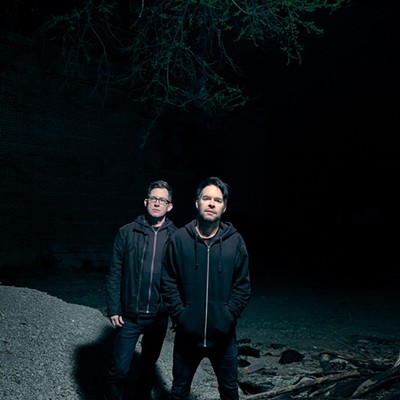Effects pedals--especially those adding thick layers of aural fuzz to a guitar's sound--helped create that revered cultural force known today as rock. And they finally get their due respect in the new documentary movie Fuzz: The Sound That Revolutionized the World.
Tucson musician Clif Taylor spent about 18 months making Fuzz, which marks his directorial debut. The movie was financed and produced by Tucson-based BrinkFilms.
Taylor will be on hand at the film's theatrical premiere this Saturday afternoon at the Loft Cinema with a display of vintage fuzz boxes. He'll also give a live fuzz-box demonstration.
In 91 minutes, Fuzz explores the history of the fuzz box, from mass-produced effects to those that are custom-made; offers thumbnail profiles of their makers, who range from eccentric to nerdy; and features interviews with musicians who use them, including Steve Albini, Peter Frampton, Billy Gibbons, J. Mascis, Jon Spencer, Jack Waterson and Chris Ross of Wolfmother.
"My basic premise was: Why are these people so obsessed with making and obtaining these boxes? I mean, some of these things go for upwards of $500 for a pedal," Taylor says over iced tea at a local hangout.
Fuzz boxes are basically simple circuits through which musicians (primarily guitarists, but also bassists and keyboards players) route the signals from their instruments to amplifiers, creatively altering the resulting sound with distortion, feedback, echo and other sonic "imperfections."
The devices often are housed in small, tough metal boxes that resemble tools used in an episode of Star Trek, if they don't actually look like flying saucers themselves. Most are triggered by a tap of the foot (or a stomp, begetting the nickname "stompboxes"), because the guitarist's hands are usually occupied. Some of these effects devices are built to look like pedals.
Playing a guitar through a fuzz box grants the sound a "dirtiness" meant to replicate, for instance, the way Link Wray's guitar sounded after he allegedly sliced his amp's speaker cones with a razor blade, or the way Dave Davies' sounded with a loose vacuum tube, Taylor says.
"I became interested in making this movie, because there is much more behind it than just making weird sounds come out of your guitar. It's very gratifying as a filmmaker to watch what extreme lengths people will go through to make their sound that little bit different from the rest of the world's."
A 45-year-old native Tucsonan, Taylor is a well-traveled guitarist and composer who has played with many bands, including some as his bon vivant alter ego, Chick Cashman. He also happens to be an invaluable repository of wisdom and trivia relating to culture, high and low.
As a journeyman guitarist who has been playing and recording for decades--he spent six years in Los Angeles playing music and working as a film editor--Taylor has accumulated a collection of his favorite effects boxes and pedals.
Taylor appears for brief periodic cameos throughout Fuzz, demonstrating the effects of different fuzz boxes. He's depicted playing a guitar through the various devices, showing off examples from his snazzy shoe collection as he caressingly triggers each effect.
Although he has played through many a fuzz box over the years, Taylor's favorite is probably the Fuzzrite, which was produced by the Mosrite company. But he notes that the British independent company D*A*M has created a knockoff called the FUZZrong, "which just kicks ass."
Part of the magic of Taylor's film is that it looks at established manufacturers of fuzz boxes, such as Electro Harmonix, which makes thousands of Big Muffs, and smaller "boutique" makers such as D*A*M, Analog Man, Robert Keeley, Bjorn Juhl, Death by Audio and others.
"These guys range from the super-pocket-protector guys and MIT engineers to old heshers with a Heathkit (an electronic hobby set) working in their garage, and a lot of them are a combination of both," Taylor says.
"There is a really a common thread among all of them, musicians and engineers alike, and it's that they are all in pursuit of a perfect sound, whether it's a perfect re-creation of a classic funky guitar sound, a totally new sound or a way to make an old sound 50 times better."
Among iconic rock tunes that rely heavily on fuzz are "In-a-Gadda-Da-Vida" by Iron Butterfly, "Over, Under, Sideways, Down" by The Yardbirds and pretty much anything from the classical psychedelic and garage-rock eras.
But Taylor's favorite fuzz-inflected rock song is perhaps "Come See Me" by The Pretty Things, which he calls "just the naughtiest thing. The singer is inviting you to come and have sex with him, and it sounds like it." So the dirtiness in that fuzz is not simply aesthetic, but sexual.
Using a fuzz box effect on your guitar is not simply a matter of audio quality. Fuzz represents the mood, momentum and grittiness of rock culture, Taylor argues.
"It's character; it's attitude; it's snarls; it's energy," Taylor says. "If you listen to (The Rolling Stones') 'Satisfaction,' it wouldn't be the same song without the fuzz on Keith Richards' guitar. It definitely wouldn't be a hit single."
Because of obvious copyright issues, Fuzz doesn't use the music of Frampton, ZZ Top, Dinosaur Jr., Wolfmother or many of the other musicians appearing the film. Even better: The movie features an original, fuzz-drenched score composed by Taylor and played by his group, Blackwood and Co.
Taylor had provided music for two previous BrinkFilms movies, Pornstar Pets and TV Party: The Documentary, so he figured he might as well do the same for Fuzz.
"I said to myself, 'Fuck it. Why don't I do a movie and score it myself while I go?'"







